The GeForce GTX 660 Ti Review, Feat. EVGA, Zotac, and Gigabyte
by Ryan Smith on August 16, 2012 9:00 AM ESTPower, Temperature, & Noise
As always, we’re wrapping up our look at a video card’s stock performance with a look at power, temperature, and noise. Like we discussed in the introduction, while the official TDP of the GTX 660 Ti is 150W – 20W lower than the GTX 670 – the power target difference is only 7W. So let’s see which is more accurate, and how that compares to AMD’s cards.
| GeForce GTX 660 Ti Voltages | ||||
| Zotac GTX 660 Ti Boost Load | EVGA GTX 660 Ti Boost Load | Gigabyte GTX 660 Ti Boost Load | ||
| 1.175v | 1.162v | 1.175v | ||
Stopping to take a quick look at voltages, there aren’t any big surprises here. NVIDIA would need to maintain the same voltages as the GTX 670 because of the identical clocks and SMX count, and that’s exactly what has happened. In fact all single-GPU GK104 cards are topping out at 1.175v, NVIDIA’s defined limit for these cards. Even custom cards like the Gigabyte still only get to push 1.175v.
Up next, before we jump into our graphs let’s take a look at the average core clockspeed during our benchmarks. Because of GPU boost the boost clock alone doesn’t give us the whole picture – particularly when also taking a look at factory overclocked cards – we’ve recorded the clockspeed of our video cards during each of our benchmarks when running them at 2560x1600 and computed the average clockspeed over the duration of the benchmark. Unfortunately we then deleted the results for the factory overclocked cards, so we only have the “reference” card. Sorry about that guys.
| GeForce GTX 600 Series Average Clockspeeds | |||||||
| GTX 670 | GTX 660 Ti | Zotac GTX 660 Ti | EVGA GTX 660 Ti | Gigabyte GTX 660 Ti | |||
| Max Boost Clock | 1084MHz | 1058MHz | 1175MHz | 1150MHz | 1228MHz | ||
| Crysis | 1057MHz | 1058MHz | N/A | ||||
| Metro | 1042MHz | 1048MHz | |||||
| DiRT 3 | 1037MHz | 1058MHz | |||||
| Shogun 2 | 1064MHz | 1035MHz | |||||
| Batman | 1042MHz | 1051MHz | |||||
| Portal 2 | 988MHz | 1041MHz | |||||
| Battlefield 3 | 1055MHz | 1054MHz | |||||
| Skyrim | 1084MHz | 1045MHz | |||||
| Civilization V | 1038MHz | 1045MHz | |||||
The average clockspeeds on our “reference” GTX 660 Ti don’t end up fluctuating all that much. With a max boost of 1058 the card actually gets to run at its top bin in a few of our tests, and it isn’t too far off in the rest. The lowest is 1035 for Shogun 2, and that’s only an average difference of 22MHz. The GTX 670 on the other hand had a wider range; a boon in some games and a bane in others. If nothing else, it means that despite the identical base and boost clocks, our cards aren’t purely identical at all times thanks to the impact of GPU boost pulling back whenever we reach our power target.
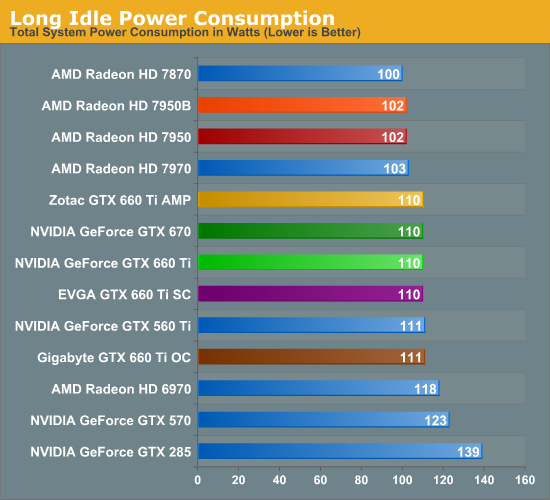
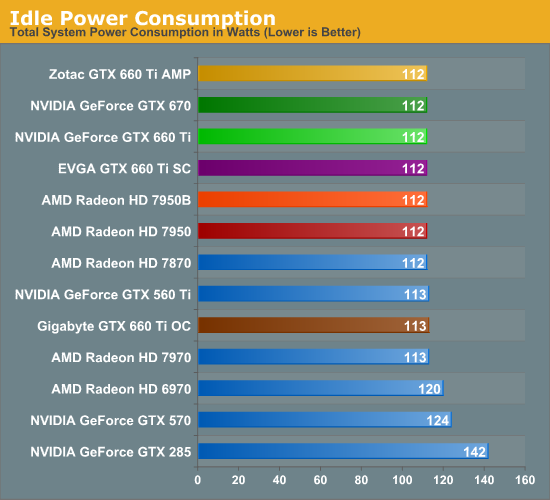
There are no great surprises with idle power consumption. Given the immense similarity between the GTX 670 and GTX 660 Ti, they end up drawing the same amount of power both during idle and long idle. This does leave AMD with an 8W-10W lead at the wall in this test though.
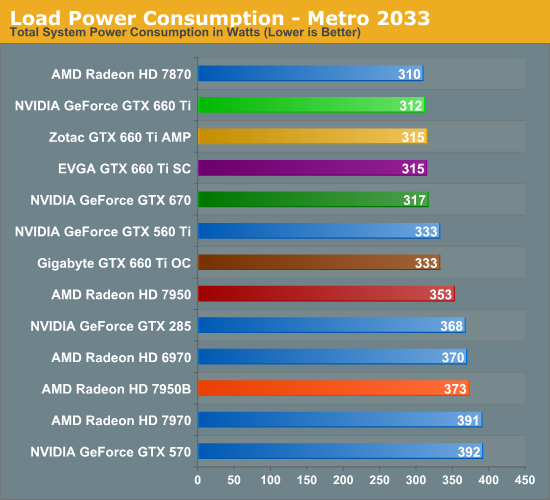
Moving on to our load power tests we start with Metro: 2033. As we mentioned previously the GTX 660 Ti and GTX 670 have very similar power targets, and this benchmark confirms that. Power consumption for the GTX 660 Ti is virtually identical to the Radeon HD 7870, an interesting matchup given the fact that this is the first time NVIDIA has had to compete with Pitcairn. Pitcairn’s weaker compute performance means it starts off in a better position, but it looks like even with a salvaged GK104 NVIDIA can still compete with it. NVIDIA drove efficiency hard this generation; to compete with a smaller chip like that is certainly a testament to that efficiency.
As for the inevitable 7950 comparison, it’s no contest. The GTX 670 was already doing well here and the GTX 660 Ti doesn’t change that. Tahiti just can’t match GK104’s gaming efficiency, which is why AMD has had to push performance over power with the new 7950B.
Meanwhile it’s fascinating to see that the GTX 660 Ti has lower power consumption than the GTX 560 Ti, even though the latter has the advantage of lower CPU power consumption due to its much lower performance in Metro. Or better yet, just compare the GTX 660 Ti to the outgoing GTX 570.
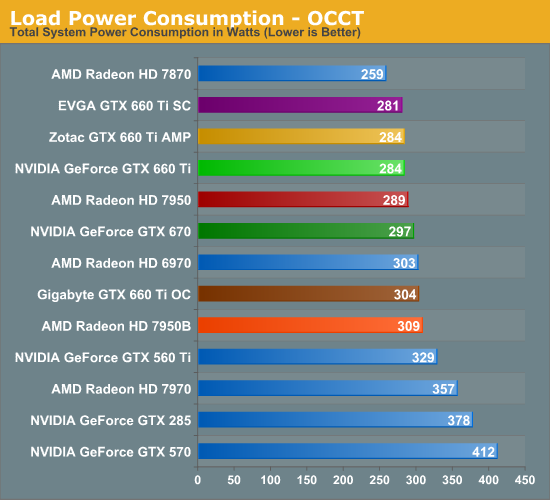
For AMD/NVIDIA comparisons we have a bit less faith in our OCCT results than we do our Metro results right now, as NVIDIA and AMD seem to clamp their power consumption differently. NVIDIA’s power consumption clamp through GPU Boost is far softer than AMD’s PowerTune. As a result the 7870 consumes 25W less than the GTX 660 Ti here, which even with AMD’s very conservative PowerTune rating seems like quite the gap. Metro seems to be much more applicable here, at least when you’re dealing with cards that have similar framerates.
In any case, compared to NVIDIA’s lineup this is another good showing for the GTX 660 Ti. Power consumption at the wall is 45W below the GTX 560 Ti, a large difference thanks to the latter’s lack of power throttling technology.
As for our factory overclocked cards, these results are consistent with our expectations. Among the Zotac and EVGA cards there’s a few watts of flutter at best, seeing as how they have the same power target of 134W. Meanwhile the Sapphire card with its higher power target is 20W greater at the wall, which indicates that our estimated power target of 141W for that card is a bit too low. However this also means that those times where the Gigabyte card was winning, it was also drawing around 20W more than its competition, which is a tradeoff in and of itself.
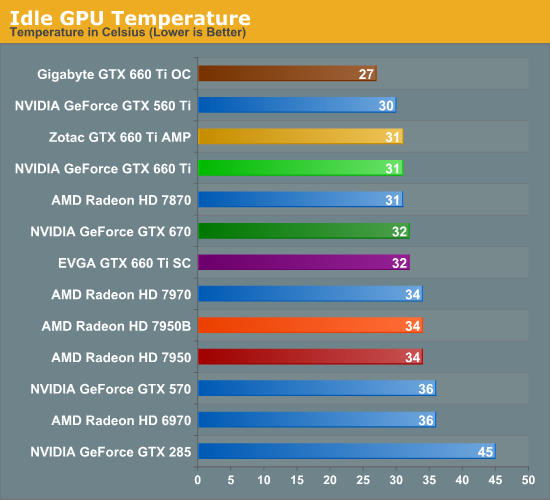
Moving on to temperatures, at 31C the GTX 660 Ti is once more where we’d expect it to be given the similarities to the GTX 670. Open air coolers tend to do a bit better here than blowers though, so the fact that it’s only 1C cooler than the blower-type GTX 670 is likely a reflection on Zotac’s cooler.
Speaking of factory overclocked video cards, one card stands out above the rest: the Gigabyte GTX 660 Ti. That oversized cooler does its job and does it well, keeping the GPU down to barely above room temperature.
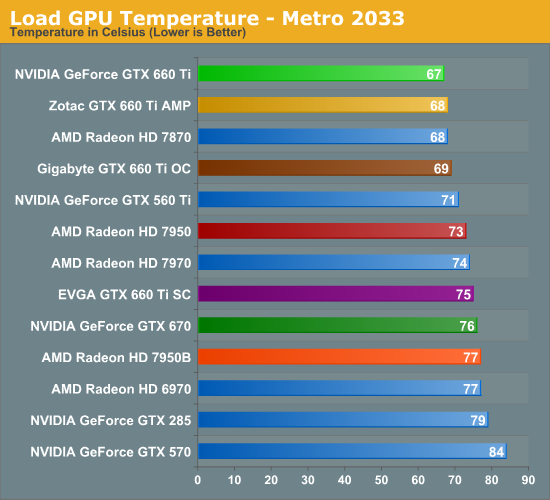
Considering that most of our high-end cards are blowers while our “reference” GTX 660 Ti is an open air cooler, temperature benchmarks are the GTX 660 Ti’s to win, and that’s precisely what’s going on. 67C is nice and cool too, which means that the open air coolers should fare well even in poorly ventilated cases.
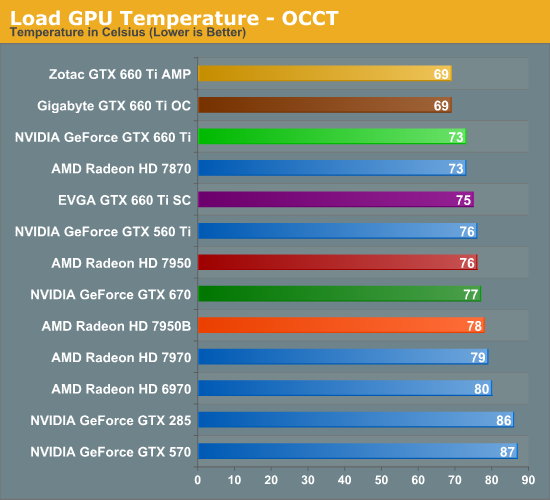
As usual we see a rise in temperatures when switching from Metro to OCCT, but at 73C the GTX 660 Ti is still the coolest reference (or semi-reference) card on the board. To be honest we had expected that it would beat the 7870, but as far as blowers go the 7870’s is quite good.
Moving on to our factory overclocked cards, we’re seeing the usual divisions between open air coolers and blowers. The blower-based EVGA card performs almost identically to the GTX 670, which makes sense given the similarities between the cards. Meanwhile the open air Zotac and Gigabyte cards are neck-and-neck here, indicating that both cards are shooting for roughly the same temperatures, keeping themselves below 70C. Though it’s somewhat weird to see the factory overclocked Zotac card end up being cooler than its reference-clocked self; this appears to be a product of where the fan curve is being hit.
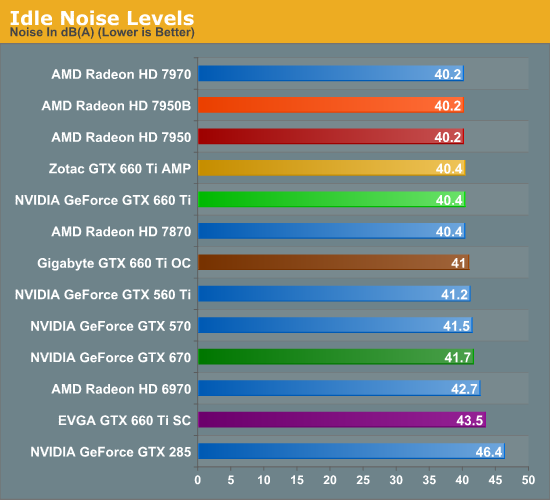
Last but not least we have our look at noise, where we’ll hopefully be able to fully shake out our factory overclocked cards.
Right off the bat we see the blower-based EVGA struggle, which was unexpected. It’s basically the same cooler as the GTX 670, so it should do better. Then again the EVGA GTX 670 SC had the same exact problem.
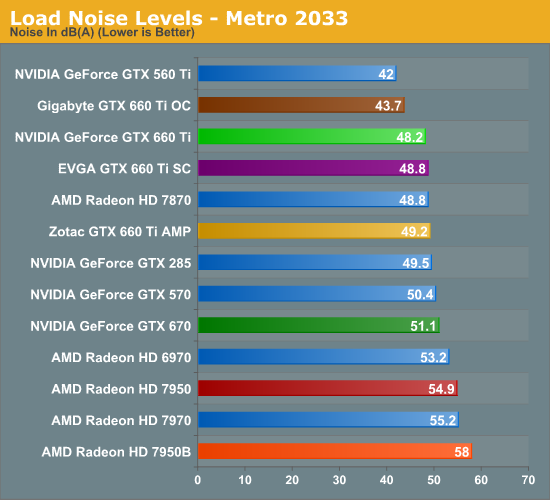
As for Metro, the GTX 660 Ti once again looks good. 48.2 isn’t the best for an open air cooler, but it’s a hair quieter than the 7870 and notably quieter than the GTX 670. The only unfortunate part about these results is that it just can’t beat the GTX 560 Ti; in fact nothing can. For its power consumption the GTX 560 Ti was an almost unreal card, but it’s still a shame the GTX 660 Ti can’t be equally unreal.
Moving on to our factory overclocked cards however, the Gigabyte GTX 660 Ti OC gets very close thanks to its very large cooler. 43.7dB technically isn’t silent, but it just as well should be. To offer the performance of a GTX 660 Ti (and then some) in such a package is quite the accomplishment.
As for Zotac and EVGA, there’s nothing bad about either of them but there’s also nothing great. EVGA’s card is about average for a blower, while Zotac’s card seems to be suffering from its size. It’s a relatively tiny card with a relatively tiny cooler, and this has it working harder to hit its temperature targets.
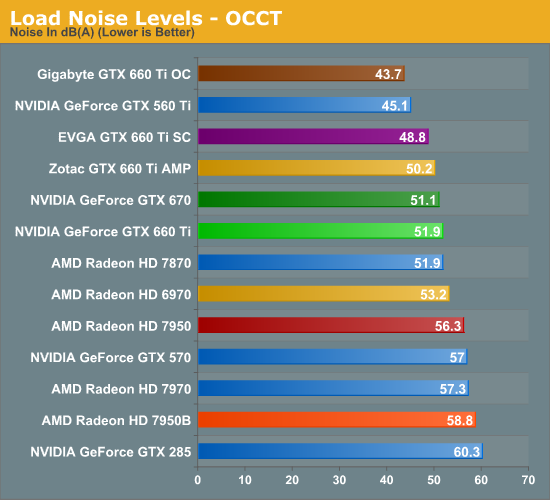
Finally we have noise testing with OCCT. Our “reference” GTX 660 Ti actually fares a bit worse than the GTX 670, which is unfortunate. So much of this test comes down to the cooler though that it’s almost impossible to predict how other cards will perform. At least it’s no worse than the 7870.
Meanwhile the Gigabyte GTX 660 Ti OC continues to impress. 43.7dB not only means that it didn’t get any louder switching from Metro to OCCT, but it has now bested the GTX 560 Ti thanks to the 560’s lack of power throttling technology. Make no mistake, 43.7dB for this kind of performance is very, very impressive.
As for EVGA and Zotac, it’s also a rehash of Metro. EVGA’s blower is actually over 1dB quieter than Zotac’s cooler, which is an unfortunate outcome for an open air cooler.
Wrapping things up, even without a true reference sample from NVIDIA it’s clear that the GTX 660 Ti has a lot of potential when it comes to power/temp/noise. Compared to other cards it’s roughly equivalent in power consumption and noise to the 7870, which for NVIDIA is an important distinction since it’s also notably faster than the 7870, so NVIDIA is on a better place on the power/performance curve. This goes for not only the 7870, but especially the 7950, where the GTX 660 Ti continues the tradition the GTX 670 already set, which will see the GTX 660 Ti being cooler, quieter, and less power hungry than AMD’s entry-level Tahiti part.
But it must be pointed out that the lack of a reference design for the GTX 660 Ti means buyers are also facing a lot of variability. Power consumption should be consistent between cards – which is to say a hair less than the GTX 670 – but temperature and especially noise will vary on a card by card basis. Potential buyers would best be served by checking out reviews ahead of time to separate the duds from the gems.










313 Comments
View All Comments
CeriseCogburn - Saturday, August 25, 2012 - link
The 660Ti has a bios SUPER roxxor feature...in the MSI version.. ROFL !! hahahahttp://www.techpowerup.com/reviews/MSI/GTX_660_Ti_...
It seems that MSI has added some secret sauce, no other board partner has, to their card's BIOS. One indicator of this is that they raised the card's default power limit from 130 W to 175 W, which will certainly help in many situations.
The card essentially uses the same power as other cards, but is faster - leading to improved performance per Watt.
Overclocking works great as well and reaches the highest real-life performance, despite not reaching the lowest GPU clock. This is certainly an interesting development. We will, hopefully, see more board partners pick up this change.
ROFL HAHAHAAHAAAAAAAAAAA
So this is the one you want now Galidou.
" Pros: This thing is pretty amazing. Tried running Skyrim on Ultra, 2k textures, and 14 other visual mods. With this card, I ran it all with no lagg at all, with a temp under 67. Love it. "
http://www.newegg.com/Product/Product.aspx?Item=N8...
Galidou - Tuesday, September 4, 2012 - link
Gibgabyte did the same, the board power is up to 180 watts if you tweak it and still both overclocked(my wife's gigabyte 660 ti OC and my 7950 sapphire 7950 OC) the 7950 wins hands down at 3 monitor resolution.How can you still trying to explain things when the only side of the medal you can speak of is Nvidia. Sorry, I see the good of both while you can't say a good thing about AMD. Both of my computer uses intel overclocked sandy bridge/ivy bridge K cpus, I'm no AMD fan but I can recognize I did the right thing and I did my research and having BOTH freaking cards in HANDS and testing them side by side with my 3570k @ 4,6ghz.
My 7950 wins @ 3 monitors in skyrim EASILY, you can't say anything to that because you ain't got both cards in hands. Geez, will you freaking understand some day. And no I ain't got any freaking problem with my drivers... And I paid the 7950 the same price than the gtx 660 ti. EXACT same price. 319$ before taxes.
Geez it's complicated when arguing with you because you ain't open to any opinions/facts other than: AMD IS CRAP, NVIDIA WINS EVERYTHING, AMD IS CRAP, NVIDIA WINS EVERYTHING, HERE'S MY LINK TO A WEBSITE THAT SHOWS THE 660TI WINNING AGAINST A 7970 AT EVERYTHING EVEN 6 MONITORS LOOK LOOK LOOK.
TheJian - Friday, August 24, 2012 - link
I was speaking to their finances. If you see in one of my other posts, I believed they deserved 20bil from Intel, but courts screwed them. That is part of what I meant. They deserved their profits and more. Tough to get profits when Intel is stealing them basically by blocking your products at every end.No comment was directed at "dumb" employees. I said it was hard to overcome, not easy. Also that they had the crown for 3 years and weren't allowed to get just desserts. I'm sorry you didn't get that from the posts. I like AMD. I just fear they're on their last financial leg. I've owned their stock 4 times over the last 10 years. There doesn't look like there will be a 5th is all I'm saying. I speak from a stock/company financial position sometimes since I've bought both and follow their income statements. I'm sure they're all great people that work there, no comment on them (besides management's mishandling of Dirk Meyer, ATI overpurchase).
felipetga - Thursday, August 16, 2012 - link
I have been holding to upgrade my GTX 460 256bits. I wonder if this card will be bottlenecked by my C2Q 9550 @ 3.6ghz....dishayu - Thursday, August 16, 2012 - link
It won't. You need to SLI/CF 2 top end cards for the processor to be a bottleneck.tipoo - Thursday, August 16, 2012 - link
Only on some games, but the majority aren't as CPU intensive as they are GPU intensive, so it would still be a nice upgrade for you.Jamahl - Thursday, August 16, 2012 - link
Do you realise that the majority of 660 Ti's being benchmarked at other techsites are overclocked vs the stock Radeons?Biorganic - Thursday, August 16, 2012 - link
Exactly this. Anyone who follows these respective cards, 7950:670, 7970:680 etc knows that the AMD alternatives have excellent overclocking potential. All these reviews are comparing high clocked GTX vs stock or very conservatively boosted AMD cards. I can get my 7950 to 1000 mHz on stock voltage. That will destroy this toy they call a TI. Sorry but the results seem a bit biased.Ryan Smith - Thursday, August 16, 2012 - link
"Sorry but the results seem a bit biased."Just so we're clear, are you talking about our article, or articles on other sites?
if it's the former, in case you've missed it we are explicitly testing a reference clocked GTX 660 Ti in the form of Zotac's card at reference clocks (this is hardware identical to their official reference clocked model).
mwildtech - Thursday, August 16, 2012 - link
Biased?? This guy is an idiot. Anandtech is the least biased tech site on the interwebs. Ryan - awesome review! keep up the good work.